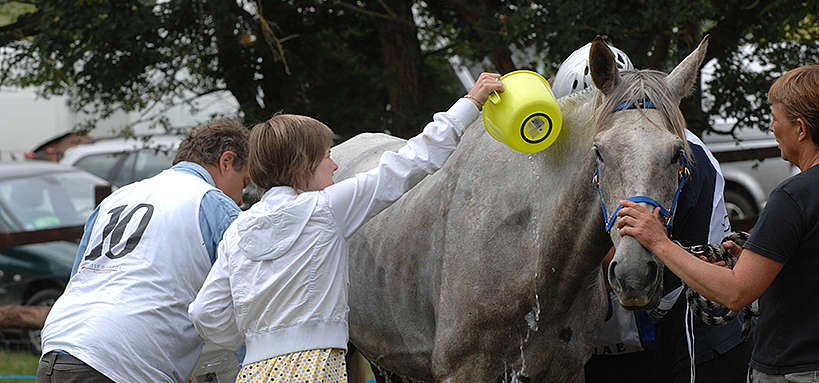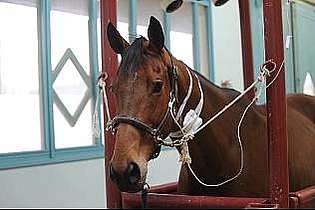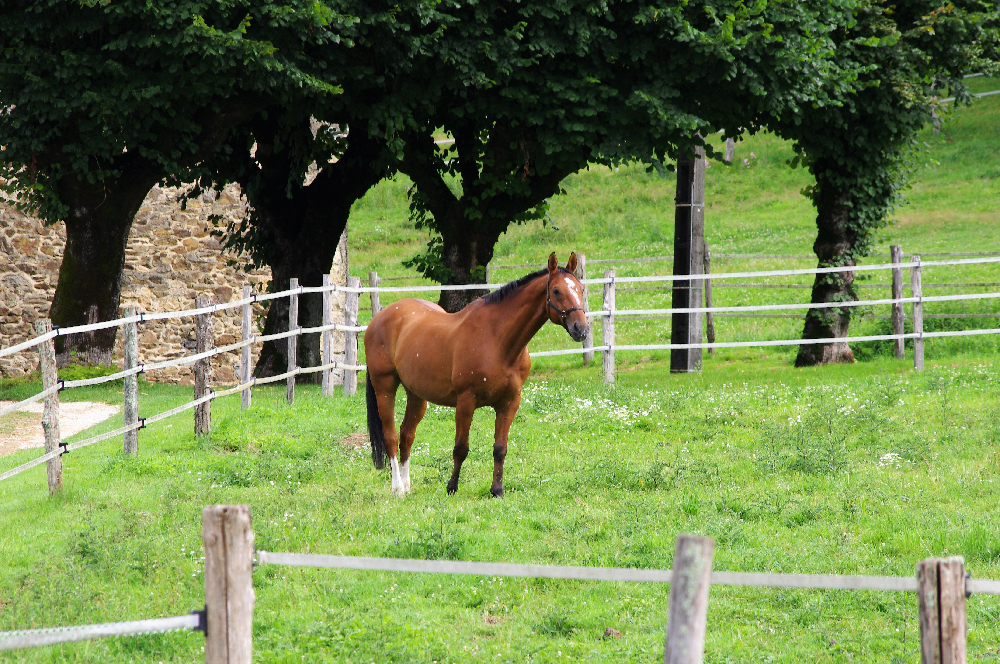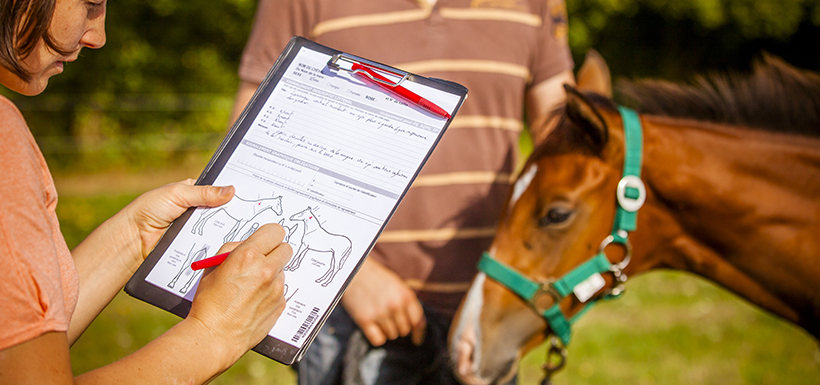

Tying up syndrome
Tying up (azoturia) is a term used to define the clinical symptoms which appear in the horse, when, following exercise or stress, back and hindquarter muscles are brutally affected. In horses, tying up can be an occasional occurrence, or can occur repeatedly.


- What is tying up ?
- What are the typical clinical symptoms of ER ?
- What are the different causes of tying up ?
- How to diagnose tying up (ER) and identify the causes of repeated tying up?
- How to treat tying up ?
- How to prevent tying up ?
- Remember
What is tying up ?
The clinical signs of tying up syndrome are due to acute destruction of lumbar and hind-quarter muscles following exercise or stress (transport, change of location….). The proper term for tying up is « Equine exertional rhabdomyolysis » (ER), meaning muscle destruction. It is also sometimes known as « Monday morning disease », as it fequently occurs after one or several days rest, when resuming work. It is also sometimes referred to incorrectly as myopathy, which describes muscular inflammation.
What are the typical clinical symptoms of ER ?
The following signs may be seen, depending on the severity of muscle destruction :
Muscular signs
- Stiffness of the hindquarters, difficulty engaging the hindquarters ;
- Lameness
- Reluctance or refusal to move
- Hard and painful lumbar and rump muscles, when palpated.
- Trembling or muscle spasms
- A camped-out stance
General signs
- Intolerance to exercise, and poor performance
- Excessive sweating
- Hyperthermia (rectal temperature >38.5°C)
- Increased respiratory and heart rates in the case of severe pain.
Urinary signs in severe cases
Dark urine due to elimination of myoglobin (protein present in muscle tissue). These clinical signs can appear during or just after exercise, even moderate, or after stressful episode.
What are the different causes of tying up ?
There are 2 types of Equine exertional rhabdomyolysis (ER)
- Occasional or sporadic rhabdomyolysis, caused by environmental factors ;
- Chronic or recurrent rhabdomyolysis, due to inherent factors, and promoted by environmental factors.
Equine exertional rhabdomyolysis occurs mainly :
- In the case of intense exertion (too long, or too fast), not adapted to the horse’s level of fitmess ;
- When the exercise is too stresful or constraining for the horse ;
- Over-exercise
- During endurance races in hot and humid conditions
- When feeding too much hard feed, in particular when the quantities of concentrated feed are not reduced while the horse is at rest for one or several days.
- When the diet is not balanced in vitamins and minerals.
Chronic ER is due to genetic predisposition of certain horses, and is triggered by the environmental factors described above. There are several forms :
- PSSM or « PolySaccharide Storage Myopathy », characterized by glucose being stored in the cells in an abnormal form (as polysaccharides), which cannot be utilized to produce energy for the cells. This form has been described in several breeds ;
- RER (or « Recurrent Exertional Rhabdomyolysis »), which is due to abnormal regulation of intracellular calcium ; This form is commonly seen in Thoroughbreds, but also French trotteur horses ;
- Myofibrillar Myopathy is characterized by myofibrillar disruption which is responsible for muscle cell contraction. This form is noted among warmbloods and Arab horses
- Malignant hyperthermia, concerns Quarter horses and associated breeds (Paint, Appaloosa)
How to diagnose tying up (ER) and identify the causes of repeated tying up?
When ER is suspected, due to clinical signs, a blood test (CBC) should be carried out to confirm diagnosis. An increase in the blood count of two enzymes CK and AST( Creatine Kinase, and aspartate aminotransferase) will be observed.
When there is no clearly identified cause, or in the case of repeated episodes, the veterinarian may attempt to identify a genetic cause, according to the breed of horse affected thanks to :
- A muscle tissue biopsy to identify any abnormalities in the muscle tissue
- Genetic tests : tests for type 1 PSSM, and for malignant hyperthermia are currently the only tests available
How to treat tying up ?
Firstly the horse should not be moved, so as not to further damage the muscles. If the horse is willing to move, place him in a quiet box that he knows. Rest is imperative until the muscle enzyme count returns to normal. Resuming work and exercise should then be undertaken very progressively

• The horse should be put on an IV drip to eliminate toxins
• Tranquilisers and muscular relaxing drugs can be administered
• Anti-inflammatory drugs (NSAIDs) can also be administered to relieve pain.
Care sould be taken not to administer any drugs to dehydrated animals, this could be harmful for the kidney functions.
How to prevent tying up ?
Regular exercise, adapted to the age and physical fitness of each horse should be adopted. A training session should comprise a warm-up period of sufficient length, breaks and muscle relaxing periods, and active recuperation after exercise. It is advisable to avoid confining a horse to the box immediately after exercise. For young excitable animals, it is extremely important to take excitement and stress into account in their exercise environment. Regular routines, and times should be used when dealing with animals who are subject to tying up
The horse’s ration of concentrated feed should be adapted to its level of work. Starch can be replaced with fats as the source of energy. For horses in light work, good quality hay can prove sufficient for their dietary needs. In all cases, starch levels should be reduced when the horse is out of work. On very hot days, or in the case of excessive sweating, electrolytes can be administered in the horse’s feed or in the water.
With horses who are subject to recurrent bouts of tying up, it is essential to look into a hereditary or genetic condition, so as to rigorously manage the horse’s diet, work and stabling.
Remember
• Tying up syndrome or Equine rhabdomyolysis (ER) is a disease causing acute muscle destruction, following exercise or stress.
• Certain horses are genetically predisposed to recurrent ER, and need to be subjected to adapted diet, work routine and stabling.

Know more about our authors
- Translated from french by : Karen DUFFY Translator
- Marie DELERUE Veterinarian - development engineer IFCE
- Bénédicte FERRY Docteur vétérinaire - ingénieur de projets & développement IFCE
- Charlène DAIX Réseau d'Epidémio-Surveillance en Pathologies Equines (RESPE)
- Anne COUROUCÉ-MALBLANC Docteur vétérinaire - Ecole Nationale Vétérinaire de Nantes (ONIRIS)
Bibliography
- OKE S., 2019. Tying-up in horses : where do we stand ? TheHorse.com. Disponible sur : https://thehorse.com/156866/tying-up-in-horses-where-do-we-stand/








